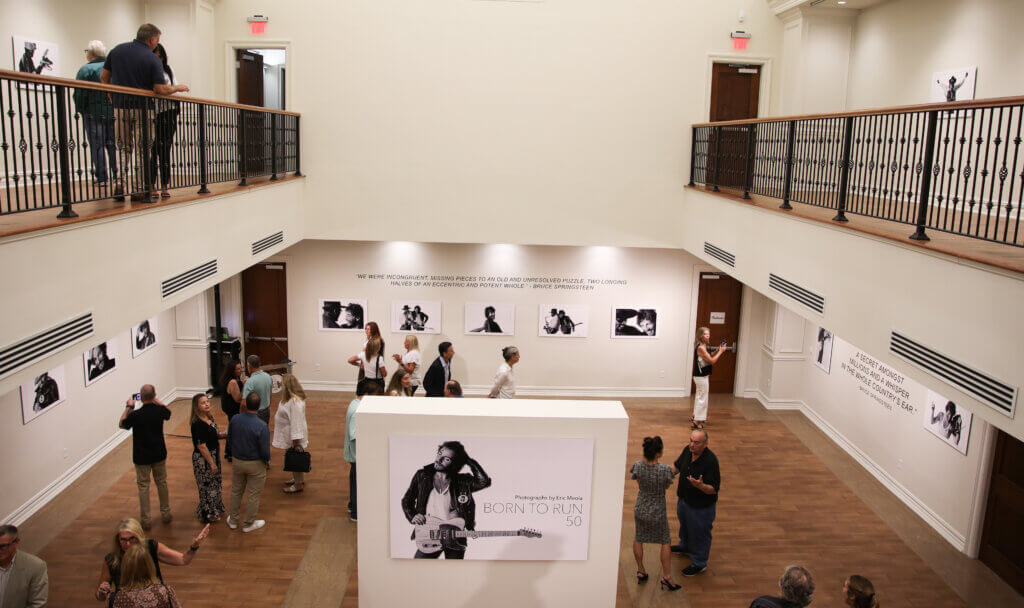Born to Run is widely regarded as the album that saved Bruce Springsteen’s career and established him as one of the defining voices of American music. Before its release, the future of Bruce’s career was uncertain. Though he had been hailed by Columbia Records as a promising new talent and called a potential successor to Bob Dylan, his first two albums, Greetings from Asbury Park, NJ (1973) and The Wild, the Innocent & the E Street Shuffle (1973), had failed to achieve significant commercial success. Critics admired his lyricism and impassioned live performances, but record sales underwhelmed.
By 1974, Springsteen faced the very real possibility of being dropped from his label if his next release did not have wider commercial appeal.
Recognizing the stakes, Springsteen hunkered down in a rented cottage in Long Branch and poured everything he had into Born to Run. He wanted to create not just a collection of radio-friendly songs, but a record that felt like a cinematic experience – an album that captured the yearning, frustration, and determination of young people chasing dreams while confronting limitations.
The result was an album that electrified both critics and audiences. When Born to Run was released on August 25, 1975, it immediately set Springsteen apart from his peers. The title track, with its sweeping scope and rousing chorus, became a rallying cry for restless youth. Songs like “Thunder Road” and “Jungleland” showcased Bruce’s ability to tell deeply personal stories that were simultaneously universal, weaving narratives of struggle, love, and escape into epic rock ballads. The album’s themes resonated strongly in a decade marked by economic uncertainty and cultural shifts, offering a raw combination of both realism and, perhaps somewhat idealistically in spite of it all — hope.
Even if the album was not so important to Springsteen’s career — the album cover would still be a monumental work of art. Famed photographer Eric Meola’s now-iconic black-and-white cover shows Springsteen leaning on saxophonist Clarence Clemons.
The photo is deceptively simple: Bruce, wearing a leather jacket with guitar in hand, grins as he leans into Clarence. But that moment of camaraderie spoke volumes. It wasn’t just a portrait of a young rock star on the rise — it was a statement about brotherhood, music, and the bond that defined the E Street Band.
In the mid-1970s, an album cover showing a white guitarist and a Black saxophonist side by side carried cultural weight. It reflected both the diversity of rock’s roots and Springsteen’s vision of music as a unifying force. The image helped elevate Clarence from “sideman” to co-star, a presence as essential to the Springsteen story as Bruce himself.
The design also stood apart. While many albums of the era leaned into psychedelic color, Born to Run went stark and cinematic. Half of Bruce appears on the front, with Clarence completing the frame on the back — almost like turning a page in a story. The effect made listeners feel like they were stepping into a larger world, one of the romance, grit, and escape that the music promised.
Fifty years later, the cover remains one of rock’s most recognizable images. It’s more than just packaging — it’s mythology in a single frame.
As Meola recalls:
I had a sense of the history that was about to unfold in front of my camera on June 20, 1975. There were no assistants that day, no witnesses, no stylists, or make-up artists. I wanted no distractions, and I needed to work alone.
I knew nothing about the notebooks crammed with lyrics and phrases, and crossed-out words in which a teenage Bruce Springsteen had so assiduously kept his thoughts, ambitions, and dreams. I had simply connected to his music in a way that was immediate and that held me in its spell.
A moment of serendipity brought us together; given an opportunity, I had walked and talked my way into the arena, and I found myself in the right place at the right time. I had to make good on the words between us.
These photographs were for Bruce and for Clarence, as much as for me. Bruce was quietly passionate about writing songs, and introspective to a fault, and I wanted to photograph someone who had put his soul on the wire for the better part of a year to make eight songs. Clarence, the Big Man with a big smile, that man with the golden horn, just stood back and let it all be.
Art director John Berg took one of my photographs, folded it in half, and created an album cover that was transcendent: two friends — one black, one white — who grabbed a chance to rock our world, and became a part of us, forever.
Born to Run 50: Photographs by Eric Meola, featuring 25 outtakes from the Born to Run album cover photo shoot, will be open to the public in Monmouth University’s Rechnitz Hall DiMattio Gallery from Friday, September 5 through December 18, 2025. Admission is free. See gallery hours and more here.
Melissa Ziobro
Director of Curatorial Affairs
Bruce Springsteen Archives & Center for American Music
Monmouth University
September 5, 2025

